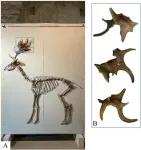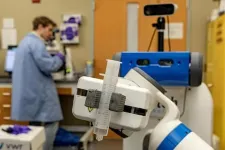(Press-News.org) Fossils from more than 600,000 years ago reveal how Southern Europe’s animal community shifted between warm and cold climate fluctuations, according to a study published October 23, 2024 in the open-access journal PLOS ONE by Beniamino Mecozzi from the Sapienza Università di Roma, Italy and colleagues.
The Notarchirico site has long been valued as a source of information on the Early-Middle Pleistocene, with fossils stretching from around 695 thousand to 614 thousand years ago. The authors of the present study examined mammalian fossils at the site and how they might correlate with climate conditions over time.
The researchers note that the earliest era documented at Notarchirico corresponded with a relatively warm period, complete with fossil evidence of genera such as hippos (Hippopotamus) and rhinos (Stephanorhinus), as well as deer and macaque monkeys — demonstrating that the area likely had woods, steppes and lakes or ponds.
But by around 660 thousand years ago, the macaques and hippos, both warm weather animals, had vanished. The mammal community had shifted to one dominated by the straight-tusked elephant (Palaeoloxodon antiquus), and cattle-like animals such as the Pleistocene wood bison (Bison schoetensacki), with relatively few deer. This indicates that the area was likely more open, with fewer forests, and representative of a colder climate, as this period is believed to have had some of the Pleistocene’s most extensive glaciation.
Fossils from the upper levels of the deposit documented at Notarchirico include a lot of deer who ate from woody shrubs and trees, indicating that the climate had likely warmed again and the area had filled in with forests.
In addition to reflecting the changing climate of the time, the fossil evidence at Notarchirico provides more insight into how and when different species moved out of and into Europe during the Pleistocene. Fossils recovered on site include some of the oldest known evidence in all of Europe of the straight-tusked elephant (Palaeoloxodon antiquus) and the red deer (Cervus elaphus), as well as some of the oldest known evidence of the cave lion (Panthera spelaea) in southwestern Europe.
The authors add: “The results of this work highlight the importance of resuming excavation and research activities at sites that were excavated in the past, as well as revisiting old museum collections that are often forgotten. By integrating the review of paleontological collections gathered in the past with the study of unpublished materials from new research, it has been possible to observe how terrestrial ecosystems responded to nearly 100,000 years of climate change.
The work published here is part of the new research project LATEUROPE, coordinated by Dr. Marie Hélène Moncel, with permission from the Soprintendenza Archeologia Belle Arti e Paesaggio of Basilicata, Direzione Regionale Musei Basilicata, and Musei e Parchi Archeologici di Melfi e Venosa, which also include the study of collections preserved at the Museo Archeologico Nazionale "Mario Torelli" and the Parco Paleolitico di Notarchirico.”
#####
In your coverage please use this URL to provide access to the freely available article in PLOS ONE: https://journals.plos.org/plosone/article?id=10.1371/journal.pone.0311623
Citation: Mecozzi B, Iannucci A, Carpentieri M, Pineda A, Rabinovich R, Sardella R, et al. (2024) Climatic and environmental changes of ~100 thousand years: The mammals from the early Middle Pleistocene sequence of Notarchirico (southern Italy). PLoS ONE 19(10): e0311623. https://doi.org/10.1371/journal.pone.0311623
Author Countries: Italy, Germany, France, Spain, Israel
Funding: This study was supported by the following funders: Progetti per Avvio alla Ricerca - Tipo 2 anno 2022”, Sapienza Università di Roma (AR222181333C1B88), and "Contributi premiali per i ricercatori e assegnisti di ricerca per rafforzarne la condizione professionale e potenziare il sistema della ricerca del Lazio” (DE G05411, 05/05/2022) to Beniamino Mecozzi; Leakey Foundation (2015–2016 and 2019–2021), the National Museum of Natural History, Paris, France (ATM, 2016–2018), and the ERC-Adv. LATEUROPE n°101052653 to Marie-Hélène Moncel; and Sapienza Università di Roma Grandi Scavi 2019 (SA11916B513E7C4B) 2020 (SA1221816893E2AB), 2021 (SA12117A87BC3F0A), 2022 (SA1221816893E2AB) to Raffaele Sardella. Alessio Iannucci is supported by a Humboldt Research Fellowship provided by the Alexander von Humboldt Foundation.
END
Fossils unveil how southern Europe’s ecosystem changed through Glacial-Interglacial Stages
Italy’s Notarchirico dig site contains some of the oldest evidence of cave lions, straight-tusked elephants and red deer in the region
2024-10-23
ELSE PRESS RELEASES FROM THIS DATE:
Your ability to balance on one leg may be a reliable indicator of neuromuscular aging, with men and women showing significant declines over the decades
2024-10-23
Your ability to balance on one leg may be a reliable indicator of neuromuscular aging, with men and women showing significant declines over the decades
###
Article URL: https://journals.plos.org/plosone/article?id=10.1371/journal.pone.0310764
Article Title: Age-related changes in gait, balance, and strength parameters: A cross-sectional study
Author Countries: U.S., Taiwan
Funding: AR-K25AG068368 RJP-Robert and Arlene Kogod Professorship in Geriatric Medicine KRK-W. Hall Wendel, Jr. Musculoskeletal Professorship The funders had no role in study design, data collection and analysis, decision to publish, or preparation of the manuscript. END ...
Most young adults in the UK consider non-consensual condom removal during sex to be wrong and a violation of consent, with almost 9 in 10 seeing it as a form of sexual assault, per survey of 18-25-yea
2024-10-23
Most young adults in the UK consider non-consensual condom removal during sex to be wrong and a violation of consent, with almost 9 in 10 seeing it as a form of sexual assault, per survey of 18-25-year-olds
###
Article URL: https://journals.plos.org/plosone/article?id=10.1371/journal.pone.0298561
Article Title: A UK survey of young people’s views on condom removal during sex
Author Countries: U.K.
Funding: The author(s) received no specific funding for this work. END ...
Under climate change scenarios, 30-44% more land in Ethiopia might become suitable for growing arabica coffee by 2080, although some cultivated areas might also become unsuitable, per modelling study
2024-10-23
Under climate change scenarios, 30-44% more land in Ethiopia might become suitable for growing arabica coffee by 2080, although some cultivated areas might also become unsuitable, per modelling study
###
Article URL: https://journals.plos.org/plosone/article?id=10.1371/journal.pone.0310945
Article Title: Analysis of current and future bioclimatic suitability for C. arabica production in Ethiopia
Author Countries: Ethiopia
Funding: The author(s) received no specific funding for this work. END ...
Cockroaches and maggots might be able to turn an invasive seaweed into a high quality compost, finds a new experimental study which provides hope for the environment and the circular economy
2024-10-23
Cockroaches and maggots might be able to turn an invasive seaweed into a high quality compost, finds a new experimental study which provides hope for the environment and the circular economy
###
Article URL: https://journals.plos.org/plosone/article?id=10.1371/journal.pone.0311483
Article Title: Invertebrate composting quality of the invasive alga Rugulopteryx okamurae, prospects for its bio-recycling, management and circular economy
Author Countries: Spain
Funding: All the financial support has been received by professor Jose Carlos García-Gómez and any funder have influence in the research. The details are: - JCGG (68/83 / 4081/0171) Organization of American ...
Implantable device may prevent death from opioid overdose
2024-10-23
The opioid epidemic claims more 70,000 lives each year in the U.S., and lifesaving interventions are urgently needed. Although naloxone, sold as an over-the-counter nasal spray or injectable, saves lives by quickly restoring normal breathing during an overdose, administrating the medication requires a knowledgeable bystander – limiting its lifesaving potential.
A team from Washington University School of Medicine in St. Louis and Northwestern University in Chicago has developed a device that may rescue people from overdose without bystander help. In animal studies, the researchers found that the implantable device detects an overdose, rapidly delivers naloxone ...
Half of young adults support prison time for non-consensual condom removal
2024-10-23
Almost nine in 10 young adults in the UK believe that removing a condom during sex without the other person’s permission is sexual assault, and around half support prison time as a penalty, finds a new study by UCL researchers.
This is the first UK study to cover views on non-consensual condom removal. It is published in PLOS ONE and surveyed 1,729 people between the ages of 18 and 25, living in the UK.
Young people were chosen as the focus of the study as, out of all demographics, they use condoms the most.
The survey consisted of several examples of non-consensual condom removal, which ...
‘Paleo-robots’ to help scientists understand how fish started to walk on land
2024-10-23
The transition from water to land is one of the most significant events in the history of life on Earth. Now, a team of roboticists, palaeontologists and biologists is using robots to study how the ancestors of modern land animals transitioned from swimming to walking, about 390 million years ago.
Writing in the journal Science Robotics, the research team, led by the University of Cambridge, outline how ‘palaeo-inspired robotics’ could provide a valuable experimental approach to studying how the pectoral and pelvic fins of ancient fish evolved ...
Study: Robotic automation, AI will speed up scientific progress in science laboratories
2024-10-23
Science laboratories across disciplines—chemistry, biochemistry and materials science—are on the verge of a sweeping transformation as robotic automation and AI lead to faster and more precise experiments that unlock breakthroughs in fields like health, energy and electronics, according to UNC-Chapel Hill researchers in the paper, “Transforming Science Labs into Automated Factories of Discovery,” published in Science Robotics, the most prestigious journal covering robotics research.
“Today, the development of new molecules, materials and chemical systems requires ...
Paleontologists discover Colorado ‘swamp dweller’ that lived alongside dinosaurs
2024-10-23
A team of paleontologists working near Rangely, Colorado, has uncovered a new (or, more accurately, very old) state resident—a fossil mammal about the size of a muskrat that may have scurried through swamps during the Age of Dinosaurs.
The researchers, led by the University of Colorado Boulder’s Jaelyn Eberle, published their findings Oct. 23 in the journal PLOS ONE.
Eberle and her colleagues named their discovery, which they identified from a piece of jawbone and three molar teeth, Heleocola piceanus. The animal lived in Colorado roughly 70 to 75 million years ago—a time when a vast inland sea covered ...
Repeated COVID vaccines enhance mucosal immunity against the virus
2024-10-23
Ghent, October 24, 2024 – During the COVID pandemic, many of us have received multiple mRNA vaccines. New work by researchers at the VIB-UGent Center for Inflammation Research, Ghent University, and University Hospital Ghent, among others, has found that such repeated vaccinations lead to the presence of mucosal antibodies, for example, inside the nose. Their work appears in Science Translational Medicine.
Protective booster shots
Part of the global response strategy against the COVID pandemic involves the administration of booster shots, or ‘vaccine updates’ to ensure ...
LAST 30 PRESS RELEASES:
The impact of family dynamics on eating behaviour – how going home for Christmas can change how you eat
Tracing the quick synthesis of an industrially important catalyst
New software sheds light on cancer’s hidden genetic networks
UT Health San Antonio awarded $3 million in CPRIT grants to bolster cancer research and prevention efforts in South Texas
Third symposium spotlights global challenge of new contaminants in China’s fight against pollution
From straw to soil harmony: International team reveals how biochar supercharges carbon-smart farming
Myeloma: How AI is redrawing the map of cancer care
Manhattan E. Charurat, Ph.D., MHS invested as the Homer and Martha Gudelsky Distinguished Professor in Medicine at the University of Maryland School of Medicine
Insilico Medicine’s Pharma.AI Q4 Winter Launch Recap: Revolutionizing drug discovery with cutting-edge AI innovations, accelerating the path to pharmaceutical superintelligence
Nanoplastics have diet-dependent impacts on digestive system health
Brain neuron death occurs throughout life and increases with age, a natural human protein drug may halt neuron death in Alzheimer’s disease
SPIE and CLP announce the recipients of the 2025 Advanced Photonics Young Innovator Award
Lessons from the Caldor Fire’s Christmas Valley ‘Miracle’
Ant societies rose by trading individual protection for collective power
Research reveals how ancient viral DNA shapes early embryonic development
A molecular gatekeeper that controls protein synthesis
New ‘cloaking device’ concept to shield sensitive tech from magnetic fields
Researchers show impact of mountain building and climate change on alpine biodiversity
Study models the transition from Neanderthals to modern humans in Europe
University of Phoenix College of Doctoral Studies releases white paper on AI-driven skilling to reduce burnout and restore worker autonomy
AIs fail at the game of visual “telephone”
The levers for a sustainable food system
Potential changes in US homelessness by ending federal support for housing first programs
Vulnerability of large language models to prompt injection when providing medical advice
Researchers develop new system for high-energy-density, long-life, multi-electron transfer bromine-based flow batteries
Ending federal support for housing first programs could increase U.S. homelessness by 5% in one year, new JAMA study finds
New research uncovers molecular ‘safety switch’ shielding cancers from immune attack
Bacteria resisting viral infection can still sink carbon to ocean floor
Younger biological age may increase depression risk in older women during COVID-19
Bharat Innovates 2026 National Basecamp Showcases India’s Most Promising Deep-Tech Ventures
[Press-News.org] Fossils unveil how southern Europe’s ecosystem changed through Glacial-Interglacial StagesItaly’s Notarchirico dig site contains some of the oldest evidence of cave lions, straight-tusked elephants and red deer in the region








